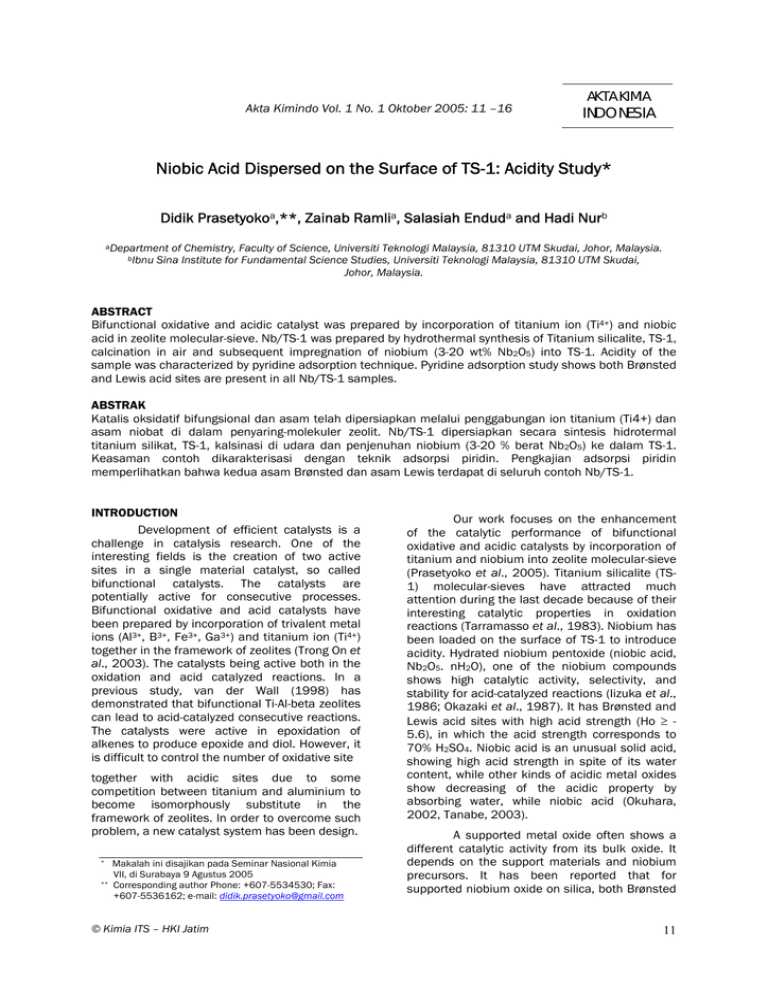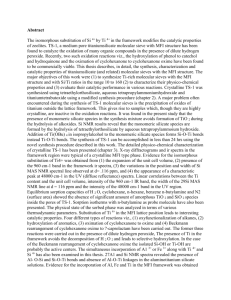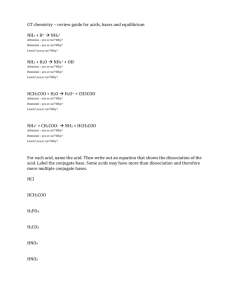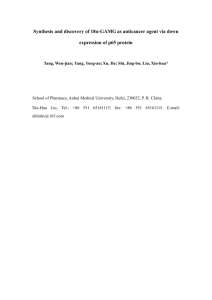Niobic Acid Dispersed on the Surface of TS-1: Acidity Study* INDONESIA
advertisement

Akta Kimindo Vol. 1 No. 1 Oktober 2005: 11 –16 AKTA KIMIA INDONESIA Niobic Acid Dispersed on the Surface of TS-1: Acidity Study* Didik Prasetyokoa,**, Zainab Ramlia, Salasiah Enduda and Hadi Nurb aDepartment bIbnu of Chemistry, Faculty of Science, Universiti Teknologi Malaysia, 81310 UTM Skudai, Johor, Malaysia. Sina Institute for Fundamental Science Studies, Universiti Teknologi Malaysia, 81310 UTM Skudai, Johor, Malaysia. ABSTRACT Bifunctional oxidative and acidic catalyst was prepared by incorporation of titanium ion (Ti4+) and niobic acid in zeolite molecular-sieve. Nb/TS-1 was prepared by hydrothermal synthesis of Titanium silicalite, TS-1, calcination in air and subsequent impregnation of niobium (3-20 wt% Nb2O5) into TS-1. Acidity of the sample was characterized by pyridine adsorption technique. Pyridine adsorption study shows both Brønsted and Lewis acid sites are present in all Nb/TS-1 samples. ABSTRAK Katalis oksidatif bifungsional dan asam telah dipersiapkan melalui penggabungan ion titanium (Ti4+) dan asam niobat di dalam penyaring-molekuler zeolit. Nb/TS-1 dipersiapkan secara sintesis hidrotermal titanium silikat, TS-1, kalsinasi di udara dan penjenuhan niobium (3-20 % berat Nb2O5) ke dalam TS-1. Keasaman contoh dikarakterisasi dengan teknik adsorpsi piridin. Pengkajian adsorpsi piridin memperlihatkan bahwa kedua asam Brønsted dan asam Lewis terdapat di seluruh contoh Nb/TS-1. INTRODUCTION Development of efficient catalysts is a challenge in catalysis research. One of the interesting fields is the creation of two active sites in a single material catalyst, so called bifunctional catalysts. The catalysts are potentially active for consecutive processes. Bifunctional oxidative and acid catalysts have been prepared by incorporation of trivalent metal ions (Al3+, B3+, Fe3+, Ga3+) and titanium ion (Ti4+) together in the framework of zeolites (Trong On et al., 2003). The catalysts being active both in the oxidation and acid catalyzed reactions. In a previous study, van der Wall (1998) has demonstrated that bifunctional Ti-Al-beta zeolites can lead to acid-catalyzed consecutive reactions. The catalysts were active in epoxidation of alkenes to produce epoxide and diol. However, it is difficult to control the number of oxidative site together with acidic sites due to some competition between titanium and aluminium to become isomorphously substitute in the framework of zeolites. In order to overcome such problem, a new catalyst system has been design. * ** Makalah ini disajikan pada Seminar Nasional Kimia VII, di Surabaya 9 Agustus 2005 Corresponding author Phone: +607-5534530; Fax: +607-5536162; e-mail: didik.prasetyoko@gmail.com © Kimia ITS – HKI Jatim Our work focuses on the enhancement of the catalytic performance of bifunctional oxidative and acidic catalysts by incorporation of titanium and niobium into zeolite molecular-sieve (Prasetyoko et al., 2005). Titanium silicalite (TS1) molecular-sieves have attracted much attention during the last decade because of their interesting catalytic properties in oxidation reactions (Tarramasso et al., 1983). Niobium has been loaded on the surface of TS-1 to introduce acidity. Hydrated niobium pentoxide (niobic acid, Nb2O5. nH2O), one of the niobium compounds shows high catalytic activity, selectivity, and stability for acid-catalyzed reactions (Iizuka et al., 1986; Okazaki et al., 1987). It has Brønsted and Lewis acid sites with high acid strength (Ho ≥ 5.6), in which the acid strength corresponds to 70% H2SO4. Niobic acid is an unusual solid acid, showing high acid strength in spite of its water content, while other kinds of acidic metal oxides show decreasing of the acidic property by absorbing water, while niobic acid (Okuhara, 2002, Tanabe, 2003). A supported metal oxide often shows a different catalytic activity from its bulk oxide. It depends on the support materials and niobium precursors. It has been reported that for supported niobium oxide on silica, both Brønsted 11 Prasetyoko, et al- Niobic Acid Dispersed on the Surface of TS-1: Acidity Study and Lewis acid sites remains bound to the support surface even in the presence of water and acts as an effective catalyst for acidcatalyzed reactions (Jehng and Wachs, 1990). This paper reported the preparation and acidity study of niobium oxide supported on TS-1, Nb/TS-1. The Nb/TS-1 was prepared by impregnation of niobium on the TS-1 using niobium ethoxide as precursor. The solid acidity was characterized by infrared spectroscopy using pyridine as probe molecule. EXPERIMENTAL TS-1 (Ti = 1 mol%) was prepared according to a procedure described by Tarramasso (1983). Sample Nb/TS-1 with various loading of niobium was prepared by impregnation technique using niobium ethoxide Nb(OC2H5)5 (Aldrich, 99.95%) precursor. TS-1 was dried in oven at 200oC for 24 h. After that, the necessary amount of niobium ethoxide was dissolved in n-hexane (Aldrich, >99%) to obtain the desired metal loading, and the required quantity of a pre-dried of TS-1 was immediately added to the clear solution with stirring. The mixture was stirred at room temperature for 3 h. The solid was recovered by evaporating the nhexane at 80oC. The acid hydrolysis was performed by addition of 20 ml solution of 0.5 M HNO3 in distilled water and aged overnight, followed by heating at 120oC until dryness. The solid was then washed with distilled water for three times and finally dried at 200oC for 24 h. Sample NbX/TS-1, in which X is percentage of niobium in wt%. For comparison on the presence of Nb species, experiments were carried out to obtain niobium oxide and niobic acid. Niobium oxide was prepared by calcination of ammonium niobium oxalate (99.9%, Aldrich) at 550oC for 3 h. The prepared particles were labeled as NBO. Niobic acid, Nb2O5 nH2O was prepared by hydrolysis of niobium ethoxide in the neutral hydrolysis method. Niobium ethoxide was dissolved in the n-hexane and water was added to this solution drop by drop under stirring and the stirring was continued for an hours. The solid was recovered by evaporation of solvent, continued by drying at 100oC. Finally, the solid was calcined at 200oC for 3 h (sample NBA). Table 1 presents the code, niobium content and preparation method of the samples. For acidity study, about 10 mg of sample was pressed at 2-5 tones for a minute to obtain a 13 mm disk. The sample was introduced in the infrared cell with calcium fluorite, CaF2 windows. The sample was heated at 200oC in vacuum condition for 16 h. The types of acid sites were examined using pyridine as a probe molecule. Pyridine was adsorbed at room temperature for a minute, continued by desorption at 150oC for an hour. The infrared spectra were collected at room temperature using Shimadzu 2000 FTIR spectrometer at 2 cm-1 resolutions. Table 1. Chemical compositions of the samples and preparation method Sample Nb/(Nb+TS-1), wt% Method Code Titanium silicalite TS-1 0.81 (gel) (*) Direct synthesis Nb2O5.nH2O/TS-1 Nb3/TS-1 3.42 Impregnation & Hydrolysis Nb2O5.nH2O/TS-1 Nb10/TS-1 9.92 Impregnation & Hydrolysis Nb2O5.nH2O/TS-1 Nb20/TS-1 19.78 Impregnation & Hydrolysis 100 Calcination 100 Hydrolysis Nb2O5 NBO Nb2O5.nH2O NBA (*) %Ti = Ti/(Ti+Si) in the initial gel. RESULTS AND DISCUSSION The type and amount of acid sites in the sample were monitored and measured by pyridine adsorption. The infrared spectra were collected after evacuation of pyridine at 150oC for an hour. Figure 1 shows the infrared spectra of the samples in the pyridine region. Sample NBO does not shows any peak which indicates that crystalline niobium oxide has no acidity. Sample NBA shows the peaks at 1636, 1609, 12 1575, 1540, 1489 and 1448 cm-1. The peaks at around 1540 and 1448 cm-1 are characteristic to Brønsted and Lewis acid sites, respectively. Similar findings have been reported by Morais et al. (1996) and da Silva et al. (2000) for niobic acid. It has been reported also that the acidity of niobic acid also depends on the calcination temperature (Hanaoka et al., 1990). The number of Lewis acid sites increased with increasing pretreatment temperatures up to 500oC and then decreased at higher temperatures. On the other © Kimia ITS – HKI Jatim Akta Kimindo Vol. 1 No. 1 Oktober 2005: 11-16 hand, Brønsted acid sites decrease with increasing temperature above 100oC. As the number of coordinated water molecules increased, the number of Brønsted acid sites decreased, the concentration of hydronium ions (H3O+) increased, and the formation of H2O - HO species is observed (Batamack et al., 1996). Niobium oxide samples containing TS-1 showed the peaks similar to that of sample NBA. However, the intensity of the characteristic peaks for Brønsted and Lewis acid sites at around 1540 and 1448 cm-1, respectively, was lower than that of sample NBA. Jehng and Wachs (1990) and Shirai (1990) have reported the evidence of the presence of both Brønsted and Lewis acid sites in niobium oxide supported on the silica, while Mendez (2003) only found Lewis acid sites in silica supported niobic acid. In this study, a mechanical mixture of niobic acid and TS-1 (20 wt% NBA + TS-1) only shows the peaks at around 1608, 1489 and 1447 cm-1, which are similar to those of sample TS-1. The infrared spectra shown in Figure 1 confirmed that all samples NbX/TS-1 have Brønsted and Lewis acid sites. The amount of Brønsted and Lewis acid sites calculated on the basis of the peak at around 1540 and 1448 cm-1 are tabulated in Table 2. It showed that the amount of Brønsted and Lewis acids increases with the increasing niobium loading on the support. The area under the peak at around 1490 cm-1 characteristic for the mixture of Brønsted and Lewis acids also increased as the niobium loading increased. This finding indicates that niobium plays a role in the formation of both Brønsted and Lewis acid sites. Similar findings have been reported by Jehng and Wachs (1990) and Shirai (1990) for niobium oxide supported on silica. Figure 2 shows the correlation between niobium content (wt%) in the solid samples and the amount of the Brønsted and Lewis acid sites. It shows that addition of niobium onto TS-1 up to 10 wt% results in increase amount of Brønsted acid sites. Although the amount of Brønsted acid sites keep on increasing with further increased in © Kimia ITS – HKI Jatim niobium loading up to 20 wt%, the additional amount of Brønsted acid produced is slightly lower compared to that of the first addition (sample Nb10/TS-1). This finding suggests that not all of the added niobium creates Brønsted acid sites. Based on to this observation, it is suggested that the Brønsted acid sites may be present only on the surface of niobic acid. Similar pattern is observed also for the formation of Lewis acid sites. According to Jehng and Wachs (1990), interaction between Nb2O5 and acidic surfaces (SiO2 and Al2O3) resulted in the formation of slightly distorted NbO6, NbO7 and NbO8 sites. The slightly distorted NbO6, NbO7 and NbO8 groups only possess Nb-O bonds and are associated with Brønsted acid sites. The highly distorted NbO6 octahedral possess Nb=O bonds in which associated with Lewis acid sites. In this study, it is found that the increased amount of Lewis acid sites present in the sample with low amount of niobium loading (Nb3/TS-1) is similar with the increased amount of Brønsted acid sites. This suggests that the amount of slightly distorted NbO6, NbO7 and NbO8 groups is similar with those of highly distorted NbO6. However, at higher niobium loading, it is found that the increased amount of Lewis acid is slightly lower than that of Brønsted acid. It suggests that at higher niobium loading, the present of slightly distorted NbO6, NbO7 and NbO8 groups is more prominent. This finding was supported by the results obtained from the TPR and infrared of hydroxyl groups data, which there was interaction between niobium species with the support TS-1 (Nb-O-Si). Since Nb is more electronegative compared to Si or Ti (Pauling value of Nb, Si and Ti are 1.6, 1.0 and 1.5, respectively) means that niobia oxide shows more ionic character. Therefore, generation of Lewis acid sites in the samples Nb/TS-1 can be a consequence of the higher ionicity of the Nb-O bond. This suggests that the higher Lewis acid could be generated in the first layer of the supported niobium oxide on TS-1. 13 Prasetyoko, et al- Niobic Acid Dispersed on the Surface of TS-1: Acidity Study T S -1 1540 N b 3 /T S -1 Absorbance, a.u. N b 1 0 /T S -1 N b 2 0 /T S -1 2 0 % N B A P h y s - M ix N B A N B O 1 7 0 0 1 6 0 0 1 5 0 0 W a v e n u m b e r, c m 1 4 0 0 -1 Figure 1: FTIR spectra of the samples after evacuation under vacuum at 200oC for 24 h followed by pyridine adsorption at room temperature and evacuation at 150oC for one hour, in the pyridine regions. Table 2: The amount of the Brønsted and Lewis acid sites and the area under the peak at around 1490 cm-1 of the samples Sample Brønsted, μmol/g Lewis, μmol/g Lewis added, μmol/g (#) Peak area at 1490, cm-2 (*) TS-1 (1%) 0 30 0.14 Nb3/TS-1 18 48 18 0.46 Nb10/TS-1 47 63 33 0.52 Nb20/TS-1 66 72 42 0.93 NBO 0 0 0 NBA 101 145 1.75 (#) Additional amount of the Lewis in the samples Nb/TS-1, calculated by deduction of Lewis acid in the samples Nb/TS-1 by sample TS-1. (*) Area of the peak at around 1490 cm-1, characteristic for the mixture of Brønsted and Lewis acid sites. Further explanation is demonstrated by pyridine adsorption, which shows that Nb-loaded TS-1 has Brønsted acid sites. On the other side, sample physical mixing of niobic acid and TS-1 (20%wt NBA) only shows Lewis acid sites. In this sample, there is no chemical interaction between Nb-O-Si. The acid sites in this sample are purely come from sample NBA with a small amount of acid sites. Meanwhile, in the Nb/TS-1 sample, the interaction between Nb-O-Si occurs. Therefore, generation of Brønsted acid sites can be expected since protons are required to balance the excess negative charges on the oxygen atoms, analog of Al atom in the aluminosilicate molecular-sieves. Generation of 14 Brønsted acid sites is also in accordance with Kung’s assumptions (Damyanova et al., 2003). They explained two models i.e. (1) an electronic interaction exists between Nb2O5 and TS-1 components, and (2) Nb-O bonds neighboring the more covalent Si-O possess a higher ionicity. It means that the electron density of the OH bonds is reduced by the inductive effect of the nearby electronegative anions. As a consequence, this weakens the OH bond and generates the Brønsted acid sites. Furthermore, based on the XPS data by Noronha et al. (1996) found the increased in the covalency of Si-O bonds in binary SiO2-TiO2 and SiO2-ZrO2 systems, respectively, that leads to the creation of Brønsted acid sites. © Kimia ITS – HKI Jatim Akta Kimindo Vol. 1 No. 1 Oktober 2005: 11-16 80 Bronsted Lewis Lewis added Acid sites, umol/g 60 40 20 0 0 5 10 15 20 25 Niobium content, wt% Figure 2: Correlation between the niobium content and the amount of acid sites of the catalysts ACKNOWLEDGEMENTS We gratefully acknowledge funding from The Ministry of Science Technology and Innovation Malaysia (MOSTI) under IRPA grant no: 09-02-060057 SR0005/09-03. REFERENCES Batamack, P., Vincent R., Fraissard, J., 1996. Catal. Today 28(1-2): 31-39. da Silva, C. L. T., Camorim, V. L. L., Zotin, J. L., Pereira, M. L. R. D., Faro Jr., A. C., 2000. Catal. Today 57(3-4): 209-217. Damyanova, S., Grange, P., Delmony, B., 1997. J. Catal. 168: 421-430. Hanaoka, T., Takeuchi, K., Matsuzaki, T. Sugi, Y., 1990. Catal. Today 8(1): 123-132. Iizuka, T., Fujie, S., Ushikubo, T., Chen, Z., Tanabe, K., 1986. Appl. Catal. 28: 1-5. Jehng, J. M., Wachs, I. E., 1990. Catal. Today 8(1): 37-55. © Kimia ITS – HKI Jatim Morais, M., Torres, E. F., Carmo, L. M. P. M., Pastura, N. M. R., Gonzalez, W. A., dos Santos, A. C. B., Lachter, E. R., 1996. Catal. Today 28(1-2): 17-21. Noronha, F. B., Frydman, A., Aranda, D. A. G., Perez, C., Soares, R. R., Morawek, B., Castner, D., Campbell, C. T., Frety, R., Schmal, M., 1996. Catal. Today 28(1-2): 147-157. Okazaki, S., Iizuka, T., Kado. S., 1987. U.S. Patents No. 4,652,544.Okuhara, T., 2002. Chem. Rev. 102(10), 3641-3666. Prasetyoko, D., Ramli, Z., Endud, S., Nur, H., 2005. Mater. Chem. Phys., 93, 443-449. Shirai, M., Ichikuni, N., Asakura, K., Iwasawa, Y., 1990. Catal Today 8: 57-66. Tanabe, K., 2003. Catal. Today 78: 65–77. Taramasso, M., Perego, G., Notari, B. 1983. U.S. Patents No. 4,410,501. Trong On, D., Nguyen, S. V., Hulea, V., Dumitriu, E., Kaliaguine, S., 2003. Microporous and Mesoporous Mater., 57, 169–180. 15


